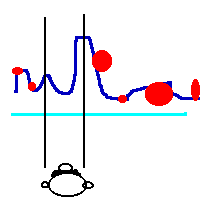
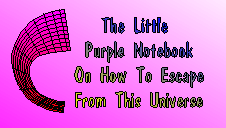
718.
The Geometry of Incident Handling
This is the attempt of a classification of the ways of handling the problem of stuck attentions on incidents.
The name 'incident handling' is somewhat misleading because it is the range of attention (or 'focus') and the associated and valued importanec of incidents (sometimes called 'charge') that is changing (or 'handled') rather than the incidents themselves.

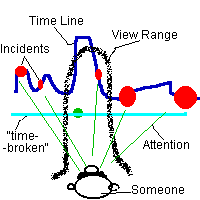
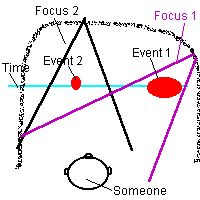
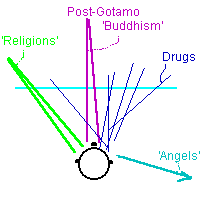
- the classic (Freud/Reich) approach is bringing past incidents into view that the person would normally hide from itself. This is done in a narrative or an associative style. A reevaluation of importances is mostly done by inspection of indirectly connected pictures, for example 'dream interpretations'.
The inherent danger of this approach is that past traumatic incidents are coming into view that may not be resolved in every case. This can increase the confusion of the person considerably and in some cases drive it over the edge.
- the 'dianetics' approach differs from the classic approach in making sure that the stirred-up incidents are 'discharged' (resolved) by guiding the person to re-experience the incident from the beginning to its end repetitively. This technology includes also the handling of 'misdirectors'. These are circuits that prompt a person to look into a different direction everytime its view comes close to a certain traumatic incident.
- the (Hubbard) 'scientology'
approach increases the control of a higher layer of a person, called 'thetan'.
This increase typically leads to an invalidation of the 'lower' layers,
the body aspects, and to an identification of the Being with
(and only with!) its
'spirit body', the 'thetan'.
- L. Kin's approach is to dissect the incidents into the proper ownership first and then removing the postulates/decisions that have been associated with the incident.
- Dennis Stephen's approach (TROM) is to view past incidents and current, present time, equivalents _at the same time_. This process, called 'time-breaking', can bring about a collapse of the time distortion associated with the dispersed attention ranges of a person. It is nothing for the faint-hearted.
Originally (?) proposed
by Filbert and Barkley, this process had its place AFTER 'conventional'
incident AND postulate processing where it becomes not only a smooth process
but where the person also should be able to handle any problems
on the spot and 'solo',
meaning without the help of another person itself. Filbert called the process
fittingly the (time-) 'trackblaster'.
Stephens puts postulate/GPM
processing AFTER the 'completion' of 'time-breaking'. There are several
problems with this sequence, most notably that GPM processing will bring
NEW old incidents into view that could not have been 'time-broken' properly
before. This is, of course, a conflict with the
premise of the sequence
of 'levels'.
For some people the
name 'time-breaking' appears to be misleading. Korzybski, in many aspects
a prime contributor to 'dianetics' and 'NLP', called the rearrangement
of time of a person's view 'time-binding' which can have the
appearance of the
opposite of 'time-breaking' even though the goal is similar.
- Gotamo's approach
appeared to be to gradually INCREASE the focus of a person, beginning with
a position of a sharply narrowed focus. This process (described elsewhere
in the notebook) blows out the incidents at the edges
of the focus. Like
the 'track blaster' process, this is also nothing for the faint-hearted
either. However, it cuts down considerably on the complexity of the 'technologies'
used.
- the post-Gotamo,
or 'Buddhist' approach, as practiced by most Buddhist schools today, is
stuck in the first stage of narrowing the focus, the 'concentration' part
(cp. Prep Trap). This obviosly resolves NOTHING at all and can immobilize
a person completely by postponing the resolution process. (cp. 'The Perversion
of Introversion and Extroversion vs. the Concept of Permeation').
The underlying
assumption is mostly
that 'time would heal all wounds'. Nothing could be more wrong than this
statement and it seems nearly superfluos to say that it is very obviously
in direct contradiction to the 'karma' concept.
For completeness, here are some other 'ways' to cope with the problem of dispersed attentions:
- the pseudo-handling of the prevailing religions consists in redirecting the attention of a person to a point in the distant future, typically after the death of the physical body. This can bring about a temporary 'high' but, like a drug, the following 'low' will be all the more painful.
- time and space are heavily interconnected. As much as it is desirable to resolve the 'time-track', the fixation on space should also be broken ('space-breaking' so to speak).
By redirecting the attention to a sane terminal in the far distance, such as the focus on 'angels', can bring a (temporary) relief similar to the after-life focus. This 'way' can be found in most traditional religions and 'New Age' approaches. It is also destined to break down as soon as a person 'looks back' on its time/space track more closely.
- drugs are diverting the focus of a person to some random point on the time/space track. There is a statistical chance that it may resolve an incident here and there, but it usually does the exact opposite by convoluting the track even further. Incidents restimulated by drugs, meaning without control of the person, can have devastating effects (horror trips) during the restimulation, and can dramatically impede the succesfull resolution of dispersed attentions at a later time.
A significant part of the confusion is caused by not sorting out the different layers of a personality (cp. "Anatomy of Case").
This seems to give approaches like that of L.Kin (who dissects the parts first) or Gotamo (who expands in time/space gradually for all parts concurrently) a considerable edge.
However, a person, at the wake of awakening, finds itself in a certain situation in time and space and has to develop out of its cultural and individual context.